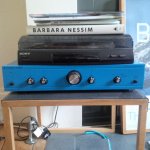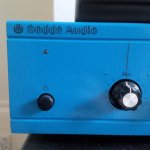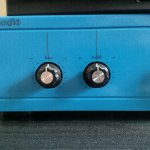I just pulled this amplifier out of a skip, and it works fine...on one channel.
Opening it up displays a very clean interior with no signs of damaged components. Are there known weak spots for this amplifier that I should cast my eye over? Transistors are not my strong point, but with a spot of guidance I'm sure it can be fixed.
Opening it up displays a very clean interior with no signs of damaged components. Are there known weak spots for this amplifier that I should cast my eye over? Transistors are not my strong point, but with a spot of guidance I'm sure it can be fixed.
Is there a pre-out?
Does it feed back in via traces or via RCA/phono?
Swapping channels can help a lot in trying to find where the fault could be.
Do you have a voltmeter?
Does it feed back in via traces or via RCA/phono?
Swapping channels can help a lot in trying to find where the fault could be.
Do you have a voltmeter?
Is there a pre-out?
Does it feed back in via traces or via RCA/phono?
Swapping channels can help a lot in trying to find where the fault could be.
Do you have a voltmeter?
Thank you AndrewT. Do you mean NFB in the circuit? If so, I don't know as I've not investigated the circuit. It's all on discrete boards and hard to remove - I had to travel away on business so didn't have time to de-solder the board's wires and see underneath. I wondered if there was a common failure-mode on these amps.
I have a voltmeter (and an AVOmeter I'm fixing up for my valve work) but have no experience with transistor circuits. I'm entirely capable of fixing it with the right guidance, however!
@JonSnell Electronic Thank you - I understand after another search (a section on a dead channel in this amp is hidden halfway through another thread on this forum that I didn't spot in my initial searching) that these can blow. There is no obvious damage, so perhaps if you could give me some pointers on how to check for this with a 'scope (I have one but little knowledge of it) or meter I'd be grateful.
I understand it's not the greatest amp in the world, but it would make a marvellous gift for a friend once fixed and polished, and I'd rather it were repaired for the price of a few components than sent to landfill, as we seem so eager to do!
I was not referring to NFB.
A pre-out when provided is a pair of RCA/Phonos on the back panel.
Some amplifiers route the signal via these and back into the the power amp section via an adjacent pair of RCAs.
Or is there a Tape out RCA?
You can use alternative OUTs to track where the signal is present and where it is "lost."
A pre-out when provided is a pair of RCA/Phonos on the back panel.
Some amplifiers route the signal via these and back into the the power amp section via an adjacent pair of RCAs.
Or is there a Tape out RCA?
You can use alternative OUTs to track where the signal is present and where it is "lost."
I was not referring to NFB.
A pre-out when provided is a pair of RCA/Phonos on the back panel.
Some amplifiers route the signal via these and back into the the power amp section via an adjacent pair of RCAs.
Or is there a Tape out RCA?
You can use alternative OUTs to track where the signal is present and where it is "lost."
Ah, thanks. I see what you mean now. The only 'out' on the back is a 'Rec Out' with the others being inputs. There is space for a phono stage on a board, that presumably would be where a proprietary unit was placed at the factory. There's very little of the circuit visible because of these boards, but I've managed to get hold of a circuit diagram and I might be able to track the signal without drawing my own and taking all the boards out...
The phono stage was an optional customer or dealer fitted extra . From memory the main issue was overheating output stages due to the design having poor heat dissapation and low cost components . Having said that for a budget amp it was sound wise better than most in its day.
Thanks for that Konzentr8. Is that phono stage available generally or not worth it?
I'm fixing it up to give to a friend who's expressed an interest in using something other than his computer speakers and may want to play records in the future. I was going to make him a little valve phono stage, but now have little time with moving house so tweaking this salvaged amp will do. If that phono stage is defunct then I'll recommend he gets a little external one to start with.
Overheating you say? I'm surprised as there's a massive heatsink for the two ICs! :-D I must remember not to listen to any hot jazz... Do you know of any ways to ameliorate this, or general reliability fixes?
On the subject of repair, I've just had the whole thing apart and gone over it with the circuit diagram, getting the right voltages in the right places, which was confusing. I hooked up some speakers and lo and behold it was working on both channels. I have no idea why it's suddenly kicked in! Perhaps if I'm lucky it was just a switch that wasn't engaged or something. I'm checking for loose joints now...
I'm fixing it up to give to a friend who's expressed an interest in using something other than his computer speakers and may want to play records in the future. I was going to make him a little valve phono stage, but now have little time with moving house so tweaking this salvaged amp will do. If that phono stage is defunct then I'll recommend he gets a little external one to start with.
Overheating you say? I'm surprised as there's a massive heatsink for the two ICs! :-D I must remember not to listen to any hot jazz... Do you know of any ways to ameliorate this, or general reliability fixes?
On the subject of repair, I've just had the whole thing apart and gone over it with the circuit diagram, getting the right voltages in the right places, which was confusing. I hooked up some speakers and lo and behold it was working on both channels. I have no idea why it's suddenly kicked in! Perhaps if I'm lucky it was just a switch that wasn't engaged or something. I'm checking for loose joints now...
The phono stage wasn't great a separate one would be much better to be honest. The overheating issue was something to do with the chip itself due to its poor design theres something somewhere on the site about it. Thats a good sign then dry joint maybe. Might be an idea to give the pots a good clean while you are inside . Good luck.
I finished it up and got it all working. Clean pots, back together and all is well. I've only now got around to taking a few pictures as it's been at my friend's house. I had a nice time getting it powder coated; replaced the knobs with ones I prefer; printed my own waterslide transfers and laid on lots of coats of lacquer. I'm pretty pleased with how it's come out!
Attachments
- Status
- Not open for further replies.
- Home
- Amplifiers
- Chip Amps
- Dead channel Cambridge A1 Mk.3


